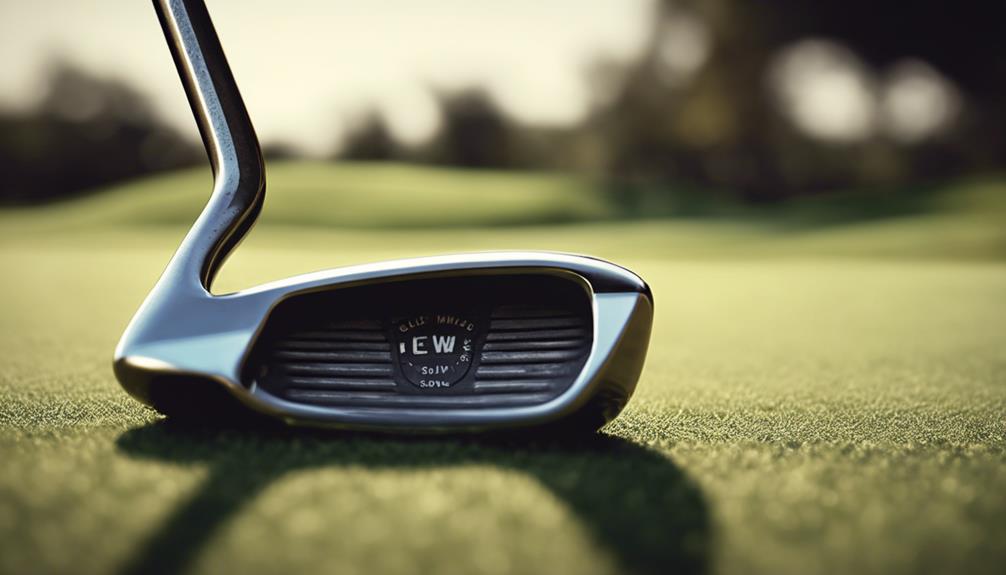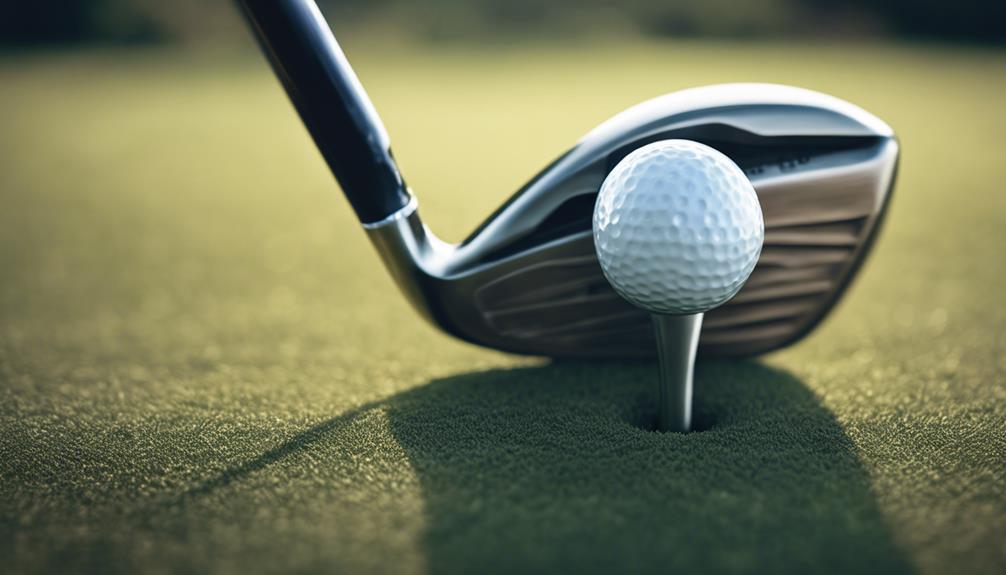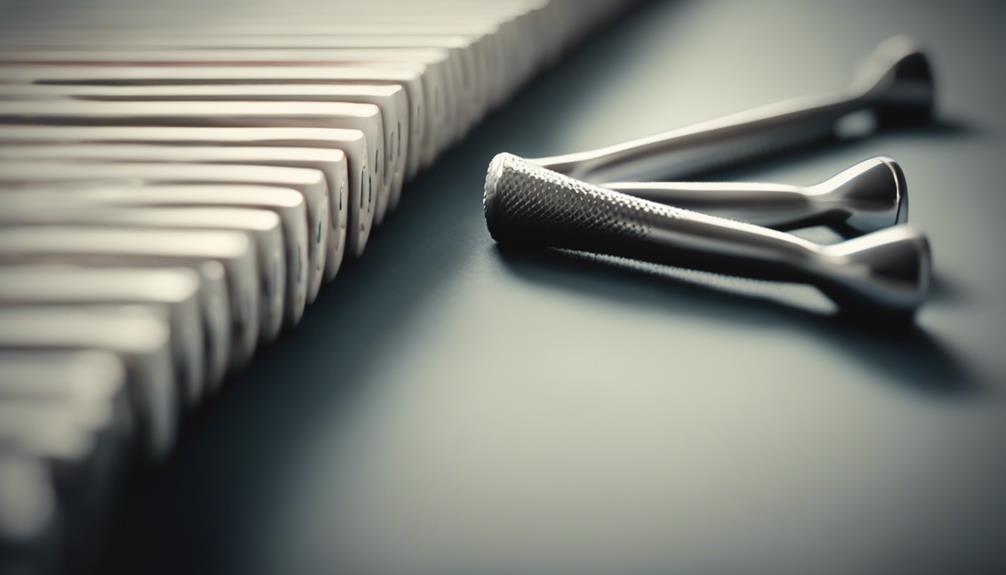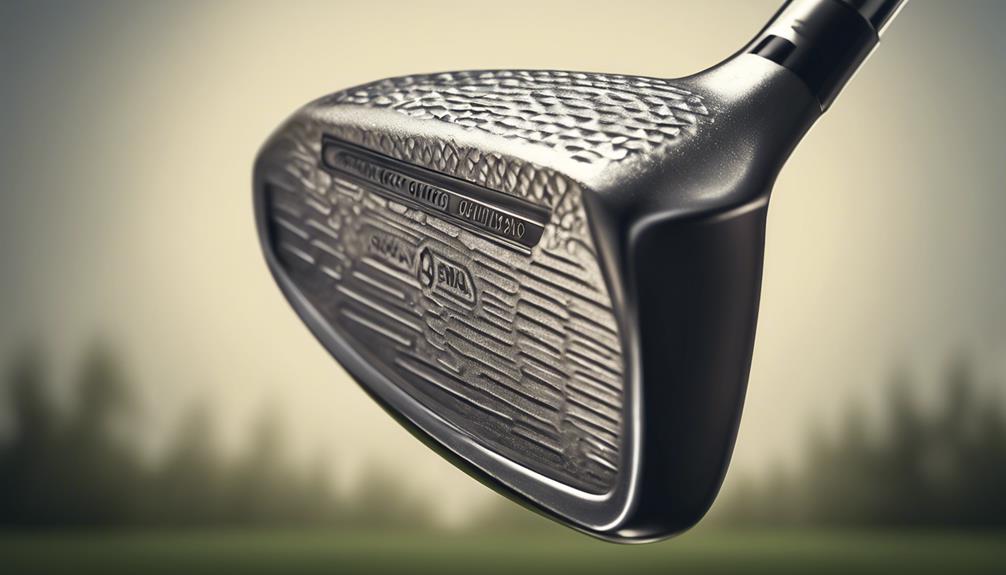- 7 Top Flite Golf Clubs XL for Improved Performance - September 28, 2024
- Top Flite Golf Clubs: Top 5 Reasons to Choose Them - September 28, 2024
- Top 3 Golf Club Fitters for a Perfect Swing - September 28, 2024
You're about to learn how to draw a golf club in 10 easy steps! First, gather your drawing tools, including graphite pencils, a sharpener, and high-quality paper. Sketch the clubhead shape, considering its proportions and overall dimensions. Add the hosel and neck, creating a smooth, continuous curve. Draw the shaft and grip, focusing on their proportions and details. Refine the clubhead details, including the face angle and groove pattern. Create the grip pattern, adding texture and tone. Shade and texture the club, bringing it to life. Add final details and lines, and then – if you're ready to take your drawing to the next level – discover how to add the finishing touches that'll make your golf club drawing truly unforgettable.
Key Takeaways
- Use graphite pencils with varying hardness levels to achieve different line weights and shading effects in your golf club drawing.
- Sketch the clubhead shape, focusing on its proportions, overall dimensions, and curvature, with a smooth and consistent curve.
- Define the shaft and grip details, considering their size, shape, and color, and experiment with different materials and styles for a realistic look.
- Refine the clubhead details, focusing on the face angle, groove pattern, and aerodynamic curves to create a professional-looking golf club.
- Distribute weight evenly between the clubhead and grip to achieve ideal balance and control, and adjust the balance point according to swing style and preferences.
Gather Necessary Drawing Tools
Gather your arsenal of drawing tools, starting with a set of graphite pencils, to bring your golf club to life. You'll need a range of pencils with varying hardness levels, such as HB, 2B, 4B, and 6B, to achieve different line weights and shading effects. Don't forget a sharpener to keep your pencils sharp, ensuring crisp lines and precise details.
In addition to pencils, invest in a blending stump or tortillon to smooth out graphite marks and create subtle gradations between shades. A ruler or straightedge will also come in handy for drawing straight lines and precise angles on the golf club. When it comes to paper, choose a high-quality, smooth paper with a minimum weight of 80gsm. This will minimize texture and allow for easy erasing and correction.
These artistic mediums will form the foundation of your drawing. With the right tools, you'll be well on your way to creating a realistic and detailed golf club. Remember, the key to mastering pencil selection is to experiment with different hardness levels and techniques to achieve the desired effects.
Sketch the Clubhead Shape
Sketch the clubhead shape, roughly outlining the oval form with gentle, flowing curves, making sure to capture its proportions and overall dimensions.
As you draw, consider the clubhead design and how it relates to golf physics. The shape of the clubhead is vital for ideal ball striking, so you must get it right. Think about the curvature of the clubface and how it will interact with the ball at impact.
Focus on creating a smooth, consistent curve, avoiding any sharp angles or abrupt changes in direction. The clubhead should be slightly wider at the top than at the bottom, with a subtle tapering effect.
Pay attention to the proportions, ensuring the clubhead is in balance with the rest of the club. Don't worry too much about the details at this stage; we'll refine them later. For now, focus on capturing the overall shape and proportions of the clubhead.
With a solid foundation in place, you'll be well on your way to creating a realistic and accurate drawing of a golf club.
Add the Hosel and Neck

Now that you've got the clubhead shape sketched out, it's time to focus on the hosel and neck.
You'll want to pay attention to the shape of the hosel, making sure it's proportional to the clubhead, and then use a gentle curve to connect it to the shaft.
As you add these details, keep in mind the connection point where the hosel meets the clubhead, as this will affect the overall look of your golf club.
Hosel Shape Defined
As you move on to the next stage of drawing your golf club, define the hosel shape by adding a curved line that connects the clubhead to the shaft. This curved line should be smooth and continuous, with a subtle 'S' shape. Think of it as a gentle, flowing merge from the clubhead to the shaft.
The hosel's evolution is closely tied to the history of golf clubs. In the early days, hosiels were more pronounced and bulbous, but over time, they've become more streamlined and refined. Today, the hosel is a critical component of a golf club's design, providing a seamless connection between the clubhead and shaft.
As you draw the hosel, remember that it's not just a functional element – it's also a visual one. The curve of the hosel should complement the overall shape of the clubhead, creating a sense of harmony and balance. Take your time, and don't be afraid to experiment with different curves and shapes until you find one that feels right. With patience and practice, you'll be able to draw a hosel that's both aesthetically pleasing and technically accurate.
Neck Alignment Guide
With the hosel shape defined, you can begin adding the neck, a critical component that connects the clubhead to the shaft and facilitates proper alignment.
To draw the neck, start by sketching a gentle, curved line that connects the hosel to the shaft, making sure it's in proportion to the rest of the club. The neck should be roughly one-quarter to one-third the length of the entire shaft, and its width should be slightly narrower than the hosel.
Pay attention to the neck's angle and orientation, as it should be slightly tilted and offset from the center of the clubhead. This is essential for achieving correct neck geometry, which is vital for proper club fitting.
The shift from the neck to the shaft should be smooth and seamless, with no abrupt changes in shape or direction. As you draw the neck, focus on creating a harmonious connection between the clubhead and shaft, ensuring that the club looks balanced and functional.
Connection Point Details
Defining the connection point between the shaft and clubhead is essential, so focus on accurately drawing the hosel and neck to create a seamless junction. This area is pivotal in golf mechanics, as it affects the overall performance of the club. To master club anatomy, you need to pay attention to these details.
The hosel is a small, tapered cylinder that connects the shaft to the clubhead, typically around 1-2 inches long.
The neck is the area where the shaft meets the hosel, also around 1-2 inches long.
Make sure the neck is slightly narrower than the shaft and slightly wider than the hosel, creating a smooth progression between the two.
Note the angle at which the neck meets the clubhead, as it should be slightly tilted to match the overall design of the golf club.
Double-check that the hosel and neck are in proportion to the rest of the club, ensuring a balanced and realistic drawing.
Draw the Shaft and Grip
You'll start by drawing the shaft, a long, thin, cylindrical shape that connects the grip to the clubhead. The shaft should be slightly tapered, with the thickest part near the grip and gradually decreasing in thickness towards the clubhead. Make sure to keep your lines smooth and consistent to give your shaft a realistic appearance.
When it comes to the grip, you'll want to examine the materials used. Common grip materials include rubber, cord, and synthetic materials. Each material has its own unique texture and appearance, so be sure to research and observe the details carefully.
Here's a breakdown of the key characteristics to think about when drawing the shaft and grip:
| Component | Description | Key Characteristics |
|---|---|---|
| Shaft | Long, thin, cylindrical shape | Tapered, smooth lines, consistent thickness |
| Grip | Material that covers the top of the shaft | Texture, color, size, and shape vary by material |
| Grip Materials | Rubber, cord, synthetic | Unique texture and appearance for each material |
| Shaft Flexibility | Measures the shaft's ability to bend | Ranges from extra stiff to senior flex |
Remember to pay attention to the proportions and details of the shaft and grip as you draw, and don't be afraid to experiment with different materials and styles to achieve a realistic look.
Refine the Clubhead Details

Now it's time to focus on the clubhead's finer details.
You'll define the shape of the clubhead, making sure it's proportionate to the shaft and grip.
Next, you'll adjust the face angle and design the groove pattern, which will give your drawing a more realistic and professional look.
Clubhead Shape Defined
As you refine the clubhead details, pay attention to the shape, which typically resembles a rounded rectangle with a slightly curved face. The clubhead's shape is a vital aspect of its design, and getting it right will make your drawing look more realistic.
The clubhead's shape should have aerodynamic curves, which allows for a more aerodynamic shape that reduces air resistance.
It should also have geometric precision, with symmetrical, clean lines and precise angles that give it a sleek, modern look.
Additionally, the clubhead's edges should be rounded, not sharp, to give it a more organic feel.
The face of the clubhead should be slightly curved, which helps to distribute the force of the swing more evenly.
Face Angle Adjustment
To achieve a more realistic drawing, adjust the face angle of your clubhead to make certain it's parallel to the target line, with the face's center slightly open or closed depending on the type of club you're drawing.
This subtle detail can greatly impact the overall accuracy of your drawing. For instance, a driver typically has a slightly open face, while a putter has a square face.
Consider the club's purpose and the golfer's swing style when determining the face angle. In Club Fitting, this adjustment is vital to secure a proper fit for the golfer's swing. Similarly, during Swing Analysis, the face angle is analyzed to optimize the golfer's performance.
Groove Pattern Design
Refine your clubhead details by focusing on the groove pattern, a key element that not only affects ball control but also contributes to the overall aesthetic of the club. The groove pattern is a vital aspect of golf club design, and getting it right can make all the difference in your game.
When designing your groove pattern, keep the following in mind:
- Groove geometry: The shape and size of your grooves can greatly impact spin optimization and overall club performance.
- The spacing and depth of your grooves will depend on the type of club you're drawing and its intended use.
- Spin optimization: Modern golf clubs often feature advanced groove patterns, such as laser-etched or milled grooves, which provide more precise control and increased spin rates.
- The design of your groove pattern can also affect the club's sound and feel, so experiment with different patterns to find the one that works best for you.
- Don't forget to verify the USGA regulations governing groove patterns to confirm your design is within the rules.
Add Weight and Balance
You'll want to distribute the weight of your golf club evenly between the clubhead and the grip to achieve ideal balance and control.
This weight distribution is vital for superior swing dynamics, as it enables you to generate more power and accuracy in your swings.
The ideal weight and balance of a golf club vary depending on your swing style and preferences, so bear in mind your individual needs.
Some golfers prefer a heavier clubhead for more power, while others prefer a lighter grip for more control.
To achieve the perfect balance, you'll need to adjust the balance point of your golf club, typically measured in inches from the clubhead.
This adjustment depends on your swing tempo and style, so experiment to find the sweet spot that enhances your performance.
You can modify the clubhead, shaft, and grip to achieve the desired weight distribution, or use weights and counterweights to fine-tune the balance.
Create the Grip Pattern

Now it's time to focus on the grip pattern, a vital aspect of drawing a realistic golf club.
You'll want to examine three key points: the size of the grip, its shape, and the texture details that bring it to life.
Grip Size Matters
When creating a golf club, getting the grip size right is essential, as it directly impacts your overall performance and swing tempo. You see, the grip size can affect your swing balance, tempo, and overall performance, making it vital to choose the correct size.
To determine the ideal grip size, you'll need to take into account your hand size and finger length. Larger hands require larger grips, while smaller hands require smaller grips.
Hand measurements play a key role in determining the ideal grip size. Grip sizes vary from junior to jumbo, with standard being the most common.
You can measure your grip size by wrapping a ruler or tape measure around the knuckles of your left hand (for right-handed golfers).
Grip variations, such as oversized or midsize, can have a profound impact on your swing.
Incorrect grip size can lead to inconsistent swings and poor performance.
Grip Pattern Shape
With the grip size determined, draw a series of circular or oval shapes around the club's handle to create a symmetrical grip pattern that fits comfortably in your hand.
These shapes should be evenly spaced and symmetrical to provide a comfortable and consistent hold. The size and shape of the grip pattern can vary depending on the type of golf club and your personal preference, but typically, they're around 1-2 inches in diameter.
As you draw the grip pattern, consider the Grip Aesthetics – how the shapes come together to create a visually appealing design.
Think about the Grip Evolution – how the grip pattern has changed over time to accommodate different playing styles and club designs. Your goal is to create a grip pattern that not only looks realistic but also tells a story about the club's history and functionality.
Grip Texture Details
As you focus on creating a realistic grip pattern, start by sketching a series of vertical lines along the grip, then add small oval shapes to create the ridges, varying the spacing and height to achieve a natural look. This will help you capture the texture of the grip material, which typically features small, rounded ridges that run vertically along the length of the grip.
To take your drawing to the next level, consider the following details:
Pay attention to the grip cap at the top of the club, which usually features a slightly different texture pattern or a decorative element, such as a logo or emblem.
Vary the spacing and height of the ridges to achieve a natural, organic look.
Consider adding subtle wear and tear to the grip, such as small scratches or scuffs, to give the impression that the club has been used extensively.
Note that the ridges can range from 0.5 to 1.5 mm in height and are spaced around 1-2 mm apart.
Don't forget to capture the subtle texture variations that can occur between different grip materials and manufacturers.
Shade and Texture the Club
You're ready to add depth and dimension to your golf club drawing by incorporating a range of shading techniques to create varying degrees of tone and texture.
To achieve this, use hatching, cross-hatching, and stippling to create a range of shading effects. Pay particular attention to the club's metal and grip areas, as these require distinct texturing approaches.
The metal should appear smooth and reflective, with subtle highlights created using gentle, smooth strokes with a white or light-colored pencil to capture Metallic Reflections.
In contrast, the grip should feature a more tactile, ridged pattern, showcasing Surface Variations.
Use a 4B or 6B pencil to create darker, more defined shading in areas such as the clubhead and shaft, and a HB or 2H pencil for lighter, more subtle shading.
Consider adding a slight gradient effect to the club's shaft to suggest its cylindrical shape and create a more realistic appearance.
Remember to vary your shading strokes to convey the club's different textures and surfaces.
With practice and patience, you'll be able to achieve a rich, detailed drawing that showcases your mastery of shading and texture.
Add Final Details and Lines

Add the final flourishes to your golf club drawing by incorporating a range of subtle details and lines that bring the entire piece together. This is where fine linework and texture exploration come into play. With a fine-tip pen, you can add the finishing touches that elevate your drawing from good to great.
Use a fine-tip pen to draw the golf ball's dimples and the club's grip pattern.
Add texture to the club's shaft by drawing short, curved lines that follow the shaft's length.
Use hatching and cross-hatching techniques to create shading and depth on the club's metal parts, such as the head and ferrule.
Draw a series of short, curved lines on the club's grip to indicate the texture of the grip material.
Color and Finish the Club
With your golf club drawing nearly complete, it's time to think about the color and finish that will bring it to life. This is where you can get creative and add a personal touch to your design. When it comes to finish options, you have a range of choices to suit your style and preferences.
| Finish Options | Design Trends |
|---|---|
| Chrome or Silver | Modern, Sleek, Corrosion-Resistant |
| Matte | Performance-Oriented, Reduced Glare |
| Powder Coated | Vibrant Colors, Durable Finish |
| Ceramic Coated | High-End, Premium Look |
| Limited Edition | Unique, Collectible, High Resale Value |
Consider the design trends that appeal to you, and choose a finish that complements your golf club's design. Remember, the finish can also affect the club's resale value, so choose wisely. With advanced techniques like electroplating, powder coating, or ceramic coating, you can achieve a high-quality finish that makes your golf club stand out.
Frequently Asked Questions
How Do You Draw a Simple Golf?
To draw a simple golf club, you'll need to master the golf basics and fundamentals first. Start by understanding the club's overall shape, then break it down into parts, like the shaft, grip, and clubhead, to create a realistic drawing.
What Is the Path for a Draw in Golf Swing?
Imagine you're Tiger Woods, aiming for a precise draw. To achieve this, you'll need to master the path for a draw in golf swing, which involves a consistent swing plane and controlled body rotation, allowing the club face to close slightly.
How to Set up for a Draw in Golf?
When setting up for a draw, you'll want to position the ball just forward of center, with the clubface alignment slightly closed to the target line, ensuring a smooth, controlled swing that promotes a draw.
What Is the Golf Grip for a Draw?
You'll achieve a draw grip by maintaining neutral grip pressure, with your right hand (for right-handed golfers) feeling slightly stronger, and adjusting your wrist angle to promote clubface closure, ensuring a consistent draw.
Conclusion
You've transformed a blank page into a realistic golf club!
The journey from rough sketch to polished drawing was a hole-in-one.
Now, your golf club illustration is ready to tee off, while your artistic skills are par-fectly on course.
With these 10 easy steps, you've mastered the swing of drawing – and who knows, maybe your next shot will be a masterpiece!




